The Picos de Europa are an incredible mountain massif located in the north of Spain, specifically in the Cantabrian mountain range. The main reasons why we have created the Guide to discover the Picos de Europa and therefore deserve even a visit once in a lifetime are the following:
- You have direct contact with Nature.
- Possibility of making multiple excursions in the open air and renewing your lungs.
- Enjoy a spectacular gastronomy.
- Possibility of seeing landscapes that would take anyone’s breath away.
We explain all this and much more in this post about our adventure Guide to discover the Picos de Europa. Go for it!.
Table of Contents
Add a header to begin generating the table of contents
1. How to Get to the Picos De Europa
1. Access from Cantabria to the Picos de Europa: The ideal is to get to Panes first. From there, we can go to Arenas de Cabrales and in this way get to know the northernmost part and that they are wonderful. Or on the contrary, if you prefer to follow the routes of the Eastern Massif, the ideal is to go from La Hermida (which also has a fantastic Spa) and to get there there is a beautiful pedestrian walkway. From there you can also go to the areas of Ándara that are also very beautiful.
If you prefer to go to the south of the national park, the ideal is to go towards Fuente Dé. There you have one of the main attractions of the region with its famous cable car that bears its own name.
2. Access from Asturias: The ideal is to arrive first in Cangas de Onís. From there, you can go south where you can see the “Path of the Archdeacon” or go to Poncebos; starting point of the “Senda del Cares” from which you can go to the famous Urriellu viewpoint. From there by the AS-262 we can reach Tielve, where there are also several routes with spectacular landscapes.
3. Access from León: From León, it is best to get to Cangas de Onís and thus be able to do everything mentioned above but also instead of going to Cangas it is better to go to Pontón and from there to Oseja de Sajambre, ending in Majada . They are all towns within the natural park and offer very beautiful routes.
4. Access to the park by public transport: There is also the possibility of visiting the Peaks and Lakes of Covadonga by public transport .
IMPORTANT INFORMATION:
Access to the park at times of greatest tourist influx is highly controlled and there may be access limitations. Especially in the months of July, August and Easter. We recommend that you inquire at the office before leaving.
2. Important Information About the Picos De Europa
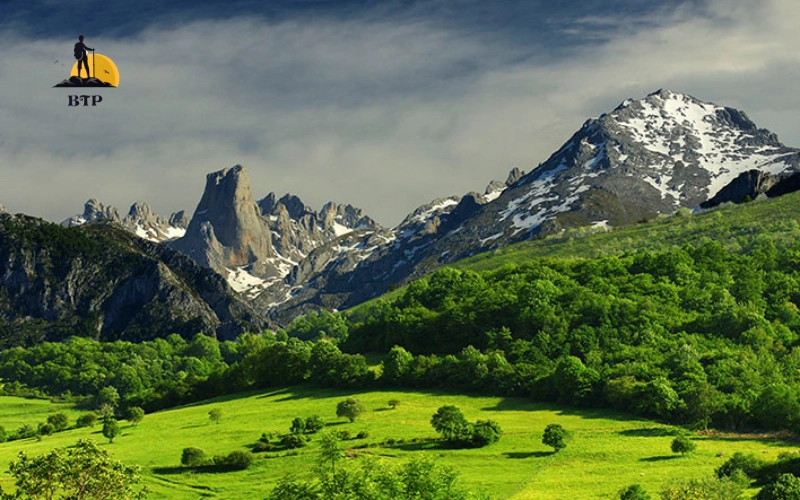
1. Permits to enter: The entrance to the park is free. Although there are services that may require payment, such as tickets to the Fuente dé Cable Car, which cost around €12 per pax.
2. The best time to visit the Picos de Europa: The truth is that the park can be visited throughout the year and each season has its charm and magic. Although personally the one we like the most is spring, when nature explodes with colors and floods all the places, giving the traveler the feeling of being in a world apart. On the contrary, I would avoid winter, due to the risk of avalanches and the increased risk of bad weather.
3. Information to take into account in the Guide to discover the Picos de Europa:
- Always wear warm clothing. Rains and mists can appear at any time of the year.
- Be careful with water, hydrate well. There are not always mono fountains and the water from these, despite being exquisite, are waters classified as “Uncontrolled Sanitary”.
- It is also important to be well equipped with food.
- Be careful with the roads, although almost all of them are passable on foot, the same is not the case with vehicles.
- It is only legal to camp in duly marked campsites and it is not allowed to make fires.
3. What to See and Do in the Picos De Europa
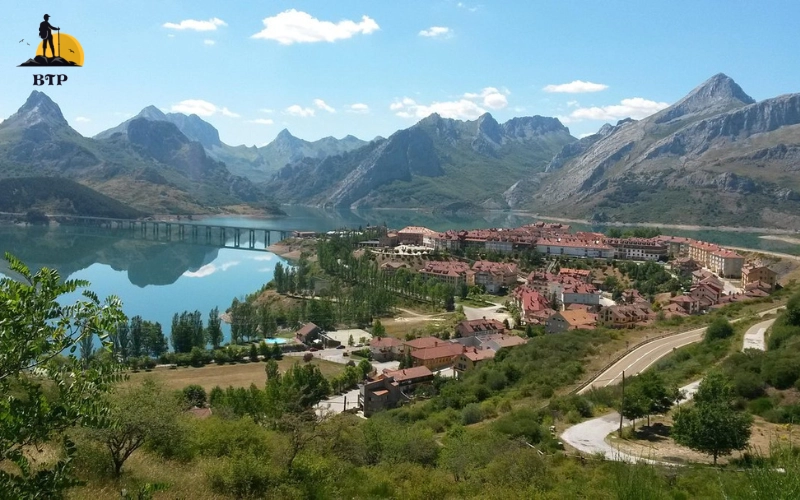
3.1 ENJOY ITS WILDLIFE AND NATURE
There are more than 2,000 species of plants throughout the park, which makes it one of the richest for botanists in our country. In it you can find mostly Atlantic vegetation with oaks, beeches, ash trees, holm oaks and of course orchids among other wonderful plants. For this reason, it is that during the spring, with the course of flowering, the park experiences all its explosion of color.
As for its animals, with luck we will be able to see several of the most emblematic birds of prey in our country such as Golden Eagles, Bearded Vultures, Egyptian Vultures, etc. Also, grouse are very typical of the park, although they are very rare for the visitor.
On the other hand, there is a good diversity of mammals, such as chamois, wolves, wild boars, roe deer, weasels and of course the King of the mountains, several pairs of brown bears. They still patrol these forests, although they will be practically impossible for the passerby to observe.
Finally, in the rivers Cares and Deva the adventurers, you will be able to find one of the last redoubts of wild salmon in our country.
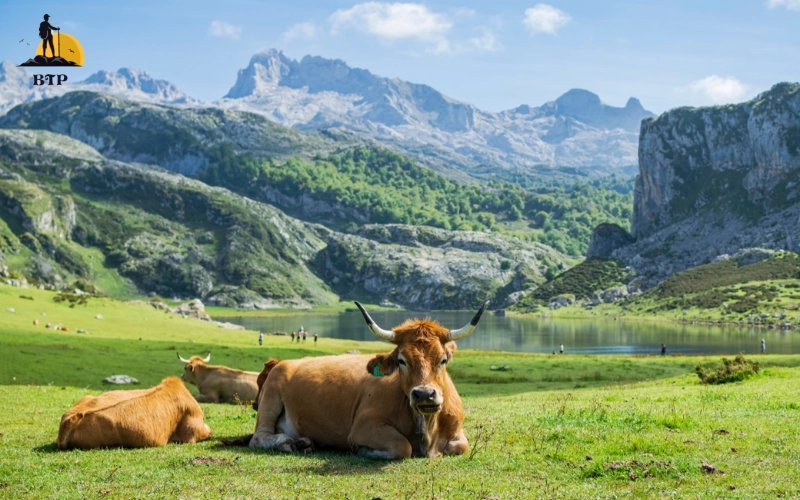
3.2 Visiting “Arenas De Cabrales”
One of the best things about discovering a region is to immerse ourselves in its gastronomy. And what better way to do it than through our Guide to discover the Picos de Europa and be dazzled by its star dish: the wonders of Cabrales cheese.
To do it we will have to go to the town of Arenas de Cabrales, located at the foot of the mountains and near the Cares route. Once there, we recommend you go visit the magnificent foundation they have on this culinary delicacy. In it, we will discover all the mysteries of this fantastic cheese, in addition to understanding part of the culture and way of life that the inhabitants of these lands had.
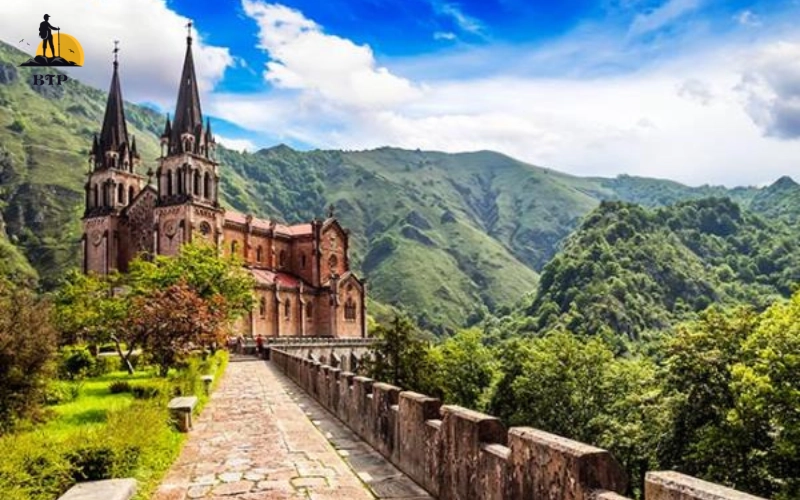
3.3 Visit “Bulnes”
If you want to continue visiting the Picos de Europa area on the Asturian side and you want to discover a bit of the culture of these places, you cannot miss one of the most charming towns in the area. It is called Bulnes and it is located between its majestic mountains. Created by shepherds from the area, Bulnes could not be missing from our Guide to discover the Picos de Europa. This town decided to give up many of its comforts to settle in this magnificent settlement, today with the possibility of visiting.
It is a town that until recently continued to preserve many of its ancient traditions and was very isolated from the rest of the world . Since it could only be accessed through a winding and spectacular path carved in stones with immeasurable landscapes that offered the traveler the opportunity to stop in time. Nowadays , this has changed a bit and there is already a rural establishment to sleep in , in addition to the fact that the town already has a rustic bar where you can eat a good fabada to the sound of a good cider.
Today you can access it either by doing the beautiful trekking of 8km and 500 meters of unevenness or by using the funicular (although the latter is quite expensive). To enjoy the views and have a drink on a charming terrace, we recommend you visit the Redondon “Casa Rafa” which you can find here.
IMPORTANT: If you wish to visit Bulnes, please maintain respect for the ancient traditions and be responsible with the environment. Let’s help each other to preserve this heritage so that it continues to preserve its charm and its essence.
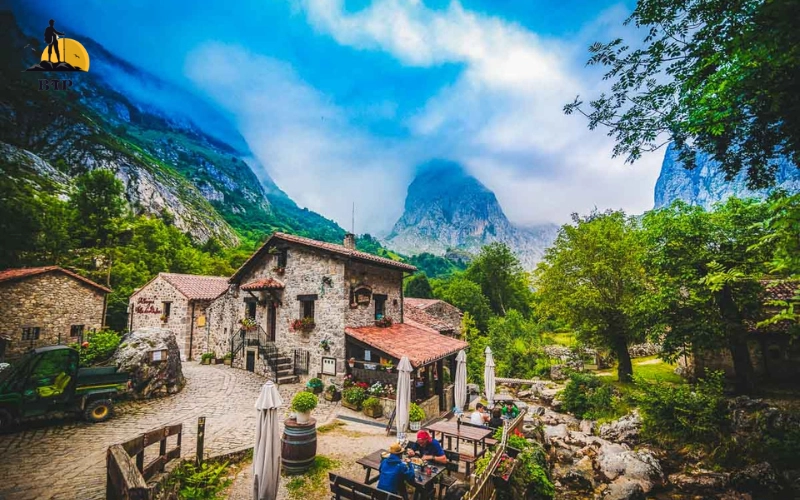
3.4 Route of Cares
The Ruta del Cares is one of the most famous and most spectacular of the Picos de Europa and the first in our Guide to discover the Picos de Europa. It has its beginnings in the 1990s, between 1916 and 1922, when the Cares River was canalized to take advantage of its influx and generate hydraulic power at the Camarmeña power plant. This forced the workers to build this rock-hardened path that now links Poncebos in Asturias with Caín in Castilla y León.
The Route runs for 12 precious kilometers very often accompanied by the Cares River and crossing the famous Cares gorge. A delicious natural wonder to cross for any adventurer.
To carry out the route, there are several ways to do it : Either we go from one place to another, either from Caín to Poncebos and then we return by Taxi (You can hire these companies: Taxi Angelín and Taxitur ) Or it is done round trip then back, and it takes about 6 hours to complete the route. The difficulty is suitable for all audiences and has no major drawbacks.
RECOMMENDATIONS:
- Hat or Cap to protect you from the heat. Something Indispensable. In summer, especially at noon, the sun can be very merciless. + Sun cream.
- Good compact binoculars to be able to spot the birds of prey that are in the area.
- A good multipurpose knife to enjoy a picnic or for any inconvenience that may occur.
- A good front in case the night falls on you.
- A good camera to immortalize the wonders of the route. A very suitable one would be the Sony A 600 for example.
- Canteen and some food.
- Backpack to carry utensils. For this type of excursion I would definitely recommend the Daxwens .
- Clothes for trekking.
3.5 Route Through the Lakes of Covadonga
An essential that could not be missing in our Guide to discover the Picos de Europa, is the also famous route through the lakes of Covadonga. This circular route that we propose is ideal for being amazed by wonderful landscapes, while enjoying a beautiful day in nature with friends or family. It is a route of little difficulty that is quite busy in high season and that offers the traveler the power to enjoy nature in all its splendor.
You can find the route in the Wikilog mobile application. Path on Wikilog Here . We use it a lot to make routes through Spain. You previously download the route and so you don’t have to worry about whether you have Wi-Fi or not.
Where to sleep: The hotel offer is not very wide but you can sleep in these hotels that adapt perfectly to the tastes and budgets of each one.
The Route itself, as we have said, is of low difficulty, you have to go to the parking lot next to Lago de la Ercina. To get there, it is best to do it through cangas de onís. From there, you just have to follow the approved path, PR-PNP on this stupendous route of just 2 hours (including stops) and about 5KM long. In it, we will be able to admire three beautiful lakes, the bufferreda mine (ideal for the youngest to play) and finally be able to observe the prince’s viewpoint. For the more religious, there is also the option of visiting the sanctuary of Covadonga and paying homage to the Virgin.
3.6 Padierna Peak and San Carlos Peak
Once we have seen the two most typical and familiar routes in our Guide to discover the Picos de Europa , we present two more routes that require more physical preparation to be able to complete them.
The first one is to crown the Pico de la Padierna and San Carlos, with a route of more than 14 km. Here we already begin to test our physique, it is a much more demanding route than the previous ones. This route has a positive difference of more than 1200m, with which the degree of hardness begins to be serious. The excursion/adventure, it is planned that it can be done in about 6/9 hours, everything will depend on your physical condition, the rod that you want to give it and the duration of the stops.
Important: This route is not signposted and no path has been approved. It is only recommended to do it in spring, summer or autumn since in winter it can be dangerous. There are also several difficult steps and somewhat aerial climbs. Careful!.
Where to sleep: The hotel offer is not very wide but you can sleep in these hotels that adapt perfectly to the tastes and budgets of each one.
The tour begins in the Cantabrian town of Fuente Dé, “Look above how to get there” and leave the car in its parking lot. From there you have to climb the walls towards PR-25 and from there towards the path of the logger, we will pass the source of the Deva river, we will pass the mines and we will arrive at the stone walls. We will pass under the famous Fuente Dé cable car until we reach the top of the cable car.
From there, you have to go towards Hoyos or Lagos de Lloroza and from there towards the San Luis channel. Through a small path, you will arrive at the classic rock walls of these places of the fabulous San Carlos peak! and Come up!!. From the San Carlos peak, you have to go down towards Colladina de las Nieves to be able to start climbing again towards the Padierna Peak!! and from there to go down again, but this time towards Vega de Liordes until the end!.
Read Also: India Tourist Places
4. Where to Sleep in the Picos De Europa
The offer to sleep in the Picos de Europa is very varied and extensive. Specifically in booking.com there are more than 500 accommodations of category, mostly rural, to stay in this natural wonder. Even so, after several years working in a travel agency, I would dare to recommend a couple of them that make a difference for me and turn your stay into a magnificent experience.
4.1 Sleeping in Asturias
If you want to stay between the sea and the mountains with all the guaranteed services, your ideal apartments are undoubtedly the Don Clemente Apartments .
If you are looking to give yourself a good tribute, the best hotel in the area is undoubtedly the Hotel Spa Maria Manuela. Perfect for after an intense day in nature and to relax in its thermal waters.
4.2 Sleeping in Cantabria
In the Cantábria area we recommend without any doubt the Posada el Corcal de Líebana . Located in a dreamlike natural environment, it has many extra services for an inn and its owner, Alfonso, will make your stay unforgettable days.
Almost on the border between Asturias and Cantábria there is a charming inn with an exquisite coffee, the Posada de Trebe . It does not leave indifferent any of the travelers who decide to stay in it.
5. Conclusions
If you like nature and trekking as much as we do, you cannot miss the Picos de Europa. It offers varied routes and for all types of physical conditions! We hope you find it useful and do not forget to write in comments if you liked it or if you have any other recommendation.
About the Author:


[…] the Guide to discover the Picos de Europa as […]
[…] Read Also: Guide to discover the Picos de Europa […]